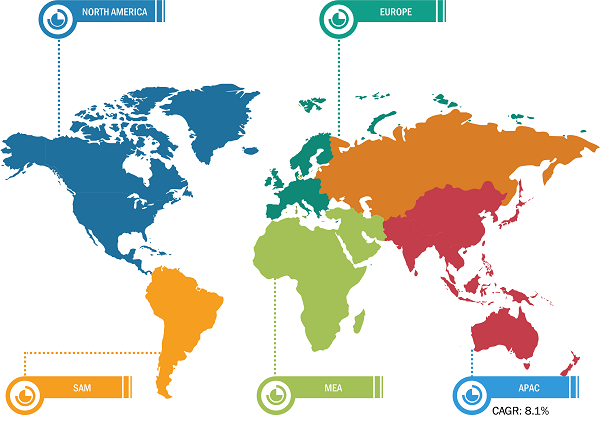Asia Pacific Dominated Precast Concrete Market in 2022
According to our latest market study on “Precast Concrete Market Forecast to 2030 – COVID-19 Impact and Global Analysis – by Structure System, and End Use,” the global precast concrete market size was valued at US$ 150.93 billion in 2022 and is projected to reach US$ 263.71 billion by 2030; it is expected to record a CAGR of 7.2% from 2022 to 2030. The report highlights key factors driving the market growth and prominent players along with their developments in the market.
Asia Pacific dominated the precast concrete market in 2022. Countries such as Australia, Japan, India, China, South Korea, Singapore, Taiwan, and Indonesia have large industries in a diverse sector such as construction, automotive, railways, and other industries. The manufacturing sector in these countries has experienced a huge shift over the years.
Global Precast Concrete Market Breakdown – by Region

Precast Concrete Market Regional Overview by 2030
Download Free SamplePrecast Concrete Market Size and Forecasts (2020 - 2030), Global and Regional Share, Trends, and Growth Opportunity Analysis Report Coverage: By Structure System (Beam and Column System, Floor and Roof System, Bearing Wall System, Façade System, and Others) and End Use (Residential, Commercial, and Others)
The manufacturing sector in Asia Pacific significantly adopts innovative accelerators, which include advanced technologies & processes. Over the past decades, the manufacturing companies spending in the region has grown significantly and is further anticipated to grow at the highest estimated growth rate.
Likewise, government initiatives and policies such as Make-in-India encourage the setup of different manufacturing plants in India. Rising foreign direct investments also lead to economic growth in the region. India, Japan, and China are among the major markets for precast concrete in Asia Pacific.
The growing number of precast concrete uses in numerous end-use sectors, including automotive and building & construction, is anticipated to increase the precast concrete demand in Asia Pacific. The building and construction industry is a strong contributor to the market’s growth. For instance, in India, the construction industry is the second largest industry after agriculture, which accounts for about 11% of the country’s GDP. Furthermore, a wide range of rail projects is either planned or under construction in the region, making it a most lucrative region for the precast concrete market. The Zhou Guanghui, Beijing Major Projects Construction, is prepared for 21 rail projects worth US$ 4.8 billion. Moreover, increasing investment in railways projects in India is further driving the growth of the market. Precast concrete is gaining interest in railway track systems for the plain track, switches and crossings, tunnels, and other applications. It is considered the most significantly performing and preferred material for railway sleepers due to factors such as long-term durability, enhanced elasticity of track, least life cycle cost, low maintenance cost, and environmental friendliness.
Cemex SAB de CV manufacturer; Holcim Ltd; Consolis Group SAS; Elementbau Osthessen GmbH & Co., ELO KG; Forterra; Centrum Pile Ltd.; Balfour Beatty Plc; and Boral are a few major players operating in the global precast concrete market. Many market players are focused on developing high-quality, innovative product offerings to fulfill the customer’s requirements.
Impact of COVID-19 Pandemic on Global Precast Concrete Market
In the pre-COVID-19 scenario, there was a significant need for affordable and rapid construction solutions, particularly in the residential sector. Precast concrete, with its high speed of installation and cost-efficiency, was increasingly preferred for housing projects. The heavy investment was made in infrastructure development, including roads, bridges, airports, and utilities. Precast concrete played a vital role in these projects due to its ability to accelerate construction schedules.
Further, various economies have started reviving their operations. Precast off-site construction mitigates the risk of pandemic, as there are fewer onsite transactions because the products are produced at the manufacturing facilities and delivered to the site. This reduces the number and coordination of trades while moderating personal contact and reducing the number of personnel needed on the site. Thus, there was a high demand for precast concrete during the pandemic.
The report segments the global precast concrete market as follows:
The global precast concrete market, by structure system, is segeregated into beam and column system, floor and roof system, bearing wall system, façade system, and others. By end use, the market is segmented into residential, commercial, and others. By geography, the global precast concrete market is broadly segmented into North America, Europe, Asia Pacific (APAC), the Middle East & Africa (MEA), and South & Central America. The global precast concrete market in North America is further segmented into the US, Canada, and Mexico. The global precast concrete market in Europe is subsegmented into Germany, France, the UK, Italy, Russia, and the Rest of Europe. The global precast concrete market in Asia Pacific is further categorized into Australia, India, Japan, China, South Korea, and the Rest of Asia Pacific. The market in the MEA is further segmented into South Africa, Saudi Arabia, the UAE, and the Rest of MEA. The global precast concrete market in South & Central America is studied on the basis of Brazil, Argentina, and the Rest of South & Central America.
Contact Us
Phone: +1-646-491-9876
Email Id: sales@theinsightpartners.com